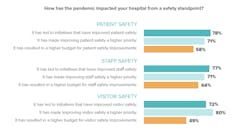VigiLanz reports on pandemic impact on hospital safety with focus on significant problems
VigiLanz, a clinical surveillance company, announced the release of its fourth annual Hospital Patient Safety Report.
The Hospital Patient Safety Report, released annually since 2019, serves as a barometer of safety performance within U.S. hospitals and reveals how safety challenges, initiatives, and priorities are evolving. The 2022 report, which also highlights the impact of the pandemic on patient, staff, and visitor safety, is based on an independent survey of 100 hospital and health system leaders conducted in January 2022 by Sage Growth Partners.
Nearly one out of three hospital executives and clinical leaders surveyed reported that their organization is not doing enough to address pandemic-exposed vulnerabilities, and nearly one out of five says pandemic-related challenges such as staff burnout and shortages are putting patients' lives in jeopardy.
"While many hospital executives and clinical leaders see significant safety problems within their organizations, the survey also reveals that most are advancing and prioritizing improvements, with about three-quarters saying the pandemic has made improving patient, staff, and visitor safety a higher priority," said VigiLanz Chairman and CEO David Goldsteen, MD. "We're excited to see the positive impact that this commitment to positive change will have on everyone within healthcare organizations."
Among the report's key findings and insights:
- 33% of hospital executives and clinical leaders say their organization hasn't done enough to address pandemic-exposed safety problems.
- 86% say burnout has led to a decline in patient safety, while 21% say it has caused patient deaths.
- 42% indicate their rate of hospital-acquired infections has increased over the past 12 months.
- 78% say the pandemic has led to new patient safety improvement initiatives, 77% say it has led to staff safety improvement initiatives, and 72% say it has led to visitor safety improvement initiatives.
"Hospital leaders are facing several safety-related challenges, but the good news is they are embracing new initiatives—and allocating more resources—to meet them," said Dr. Hayley Burgess, Chief Clinical Officer, VigiLanz.
She also noted that 64% of respondents shared that the pandemic has resulted in a higher budget for staff safety improvements, 58% report enhanced budgeting for patient safety improvements, and 49% for visitor safety improvements.
"As hospitals consider various safety improvement initiatives, implementing clinical surveillance technology is a good choice to enhance identification of safety issues which in turn expedites the improvement cycle," said Dr. Burgess.
Overall, the Hospital Safety Report shows that healthcare leaders agree that clinical surveillance technology positively impacts hospital safety, regardless of whether they are currently using the technology.
Among survey respondents who already use the technology, there is widespread agreement about the benefits. These span from an increased ability to identify and manage safety events to identifying infections or outbreaks sooner. In addition, 92% of hospital executives and clinical leaders whose organizations already incorporate technology indicate that it is supporting their hospital's efforts to respond to the pandemic.
